This incredible two-week Norway road trip itinerary includes some of the world’s most scenic driving as you wind your way past mountains, fjords, glaciers, charming villages, and spectacular coastal scenery.
From the snow-capped peaks of its mountain ranges to the iconic fjords that carve through the landscape, Norway is a strong contender for one of the most beautiful countries in the world.
Add to that an evocative history of Viking sagas telling stories of northmen and women raiding, trading and exploring far and wide in their dragon-headed longships and it’s little wonder Norway is such a popular country to visit.
Fast forward to today, and Norway somehow manages to blend its ancient heritage with a modern, progressive society that’s welcoming to visitors and easy to travel around.
Whether you’re into chasing the Northern Lights, hiking iconic fjords, kayaking glacier lakes, tasting inventive local cuisine, or just appreciating the sheer beauty of mountains and coastal villages, you’ll find it in Norway.
So, buckle up for a road trip of a lifetime through one of the most spectacular countries on the planet.
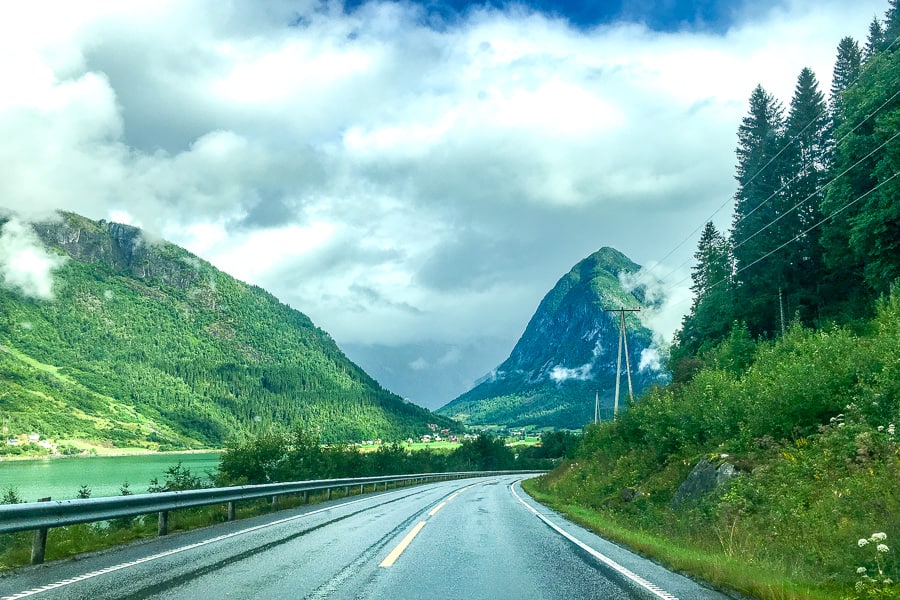
Norway Road Trip Itinerary – Snapshot
Start & Finish: Oslo, Norway
Distance: appx. 2,800km (1,740 miles)
How long do I need? Norway is a large country, and while it has great road infrastructure, the fjords and mountains that drew us here also mean that sometimes, driving can be slow-going. As such, to cover all the key highlights you’ll need at least two weeks for this Norway road trip itinerary.
Overnight stops: 3 nights in Oslo, 3 nights in Stavanger, 1 night in Bergen, 1 night in Gudvangen, 2 nights in Sogndal, 1 night in Geiranger, 1 night in Alesund, and 2 nights in Trondheim.
What’s in this post?
What’s the Route?
Planning a Norway Roadtrip
Travel to Norway
Best Time to Visit Norway
Accommodation in Norway
Driving in Norway
Car Rental in Norway
Is Norway Expensive?
Norway Road Trip Itinerary
Day 1 – Getting to Know Oslo
Day 2 – Oslo’s Nautical and Sculptural Highlights
Day 3 – Oslo to Stavanger via the North Sea Road
Day 4 – Hiking Pulpit Rock and Exploring Stavanger
Day 5 – Hiking Kjerag
Day 6 – Stavanger to Bergen
Day 7 – Bergen to Gudvangen and a Nærøyfjord Kayak Trip
Day 8 – Gudvangen to Sogndal via Flåm
Day 9 – Austdalsbreen Glacier
Day 10 – Sogndal to Geiranger
Day 11 – Geiranger to Alesund
Day 12 – Alesund to Trondheim via the Atlantic Road
Day 13 – Trondheim
Day 14 – Trondheim to Oslo
This post contains affiliate links. If you choose to buy through these links we may earn a small commission at no extra cost to you, which helps us to keep Two for the World running. Many thanks for your support!
What’s the Route?
You could spend a lifetime exploring Norway. It’s the kind of vast, rugged, beautiful, untamed place that panorama functionality on cameras was designed for. Unless you have limitless time and funds however, it may take a lifetime to see everything you want to in this diverse and beautiful country.
If you’re contemplating a Norway roadtrip, you’re probably in the position we found ourselves in: with a certain amount of time, a finite budget, and a whole world of possibilities to consider.
After extensive research and exploration in our own car, we’ve whittled down this world of possibilities into an epic 2 week Norway itinerary. The journey starts with two days in Oslo, before heading south through Stavanger, and then up to Bergen, Gudvangen, Sogndal, Geiranger, Alesund and Trondheim, then looping back to Oslo.
On the road you’ll see some of Norway’s best mountain and fjord scenery, get better acquainted with Scandinavian history, visit quaint Nordic villages and vibrant cities, explore stunning glaciers, and hike a couple of Norway’s iconic trails to some of the best vistas on the planet.
The itinerary assumes you’ll be visiting outside of the winter months. If you are chasing the aurora, or decide to visit in winter for other reasons, you may need to check road conditions, road closures and the availability of weather dependent excursions ahead of time. Make adjustments to the itinerary where the weather necessitates.
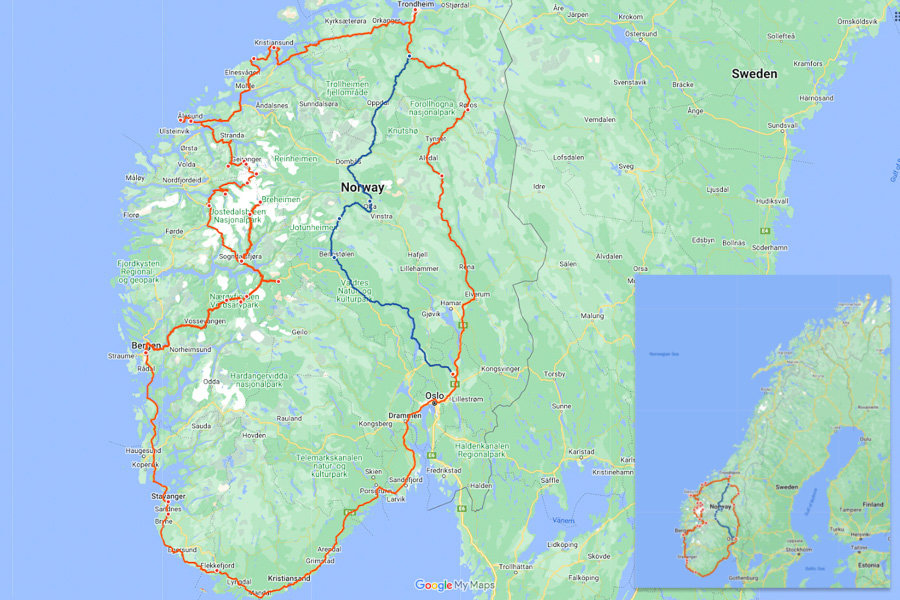
If you have the luxury of more time, and can extend your Norway road trip to three or even four weeks, you could:
- Take your time driving the coastline between Oslo and Stavanger, exploring the beaches, cuisine, and colourful wooden architecture that’s typical of the region.
- Hike the 20km (return) trail to Norway’s most distinctive rock formation, Trolltunga, for incredible views from 700 metres above Ringedalsvatnet lake.
- Extend your Nærøyfjord kayak trip to two, or even three days, to really appreciate the wonder of this World Heritage listed fjord.
- Enjoy some of the many outdoor adventures on offer in Geiranger, including hiking, biking, kayaking, ziplining or cruising down Geirangerfjord.
- Drive the Norwegian Scenic Route between Geiranger and Trollstigen to experience one of Norway’s most iconic, and panoramic roads.
- Spend a couple of days getting outdoorsy around Alesund, choosing from hiking Molladalen, Mount Saksa, or Slogen, birding at Runde Island, or exploring dramatic Hjørundfjord.
- Get better acquainted with Trondheim by visiting the many interesting museums around the city, taking a boat trip to historic Munkholmen Island, kayaking along the Nidelva River, joining a musk ox safari, walking the beautiful Ladestien path, visiting Bymarka city forest, and eating your way around some of the city’s best restaurants.
- Explore some of Norway’s most pristine natural environments on a visit to the national parks of Dovrefjell, Rondane and Jotunheimen.
Planning a Norway Roadtrip
Travel to Norway
Norway is well serviced by rail and ferry routes from adjoining countries, as well as flights from more than 100 destinations from across Europe, as well as the USA and Middle East. Be sure to get a window seat to enjoy views of Norway’s fjords and sprawling mountain scenery if you plan to fly.
Within Norway there are more than 50 domestic airports, offering connections to major cities like Bergen, Stavanger, and Trondheim, as well as far flung spots like the Lofoten Islands, North Cape, and Svalbard.
Car and passenger ferry services to Norway operate from Denmark, Germany and Sweden, so if you have the time, this might be a more leisurely way to arrive.
As we travelled to Norway with our own car, we took the ferry from Frederikshavn in Denmark to Oslo, arriving late afternoon. It’s a long and uneventful journey (which can also be made overnight), but it’s saved by good free wifi and stunning views when you sail through the Oslofjord on the final leg.
Best Time to Visit Norway
Norway offers a variety of experiences that change with the season. The best time to explore this incredible country really just depends on your interests.
The Norwegian summer, between June and August, is a time of almost perpetual daylight and warmer weather. This is prime time for hiking, cruising the fjords, and enjoying Norway’s iconic scenery and outdoor pursuits.
We visited during this period, and while tourist numbers (and prices) are definitely higher, the lively atmosphere, extended daylight hours, and warmer weather meant we were able to make the best of our time and see and do more.
For those seeking a balance between weather and crowd levels, May and September might present an ideal compromise. Spring heralds the blossoming of flora before the heat of summer, while autumn’s colourful landscapes will have you filling the memory cards of your camera. During these shoulder seasons, you can still enjoy plenty of outdoor activities with fewer crowds, and accommodation prices may sting slightly less.
Winter, between December and March, transforms Norway into a snow-draped wonderland. The Northern Lights dance in the polar night, and the snow-laden landscapes offer opportunities for skiing, dog sledding, and other winter adventures. While the days are shorter, the lure of the auroras and the snowy landscapes create a magical atmosphere that draws plenty of visitors.
Winter Considerations
Winter is undoubtedly a beautiful time of year to visit Norway, especially if you’re keen on seeing the Northern Lights or love your snow sports. However it’s also a time of year that requires extra caution, and a lot more planning.Some excursions referred to in this Norway road trip itinerary may not run during the winter months or in adverse weather conditions. Similarly, many roads through Norway’s mountains and rugged interior are closed during winter.
If you plan to visit during the winter months it’s advisable to check the availability of excursions in advance, and to regularly check road conditions and closures on the Norwegian Public Roads Administration website.
Accommodation in Norway
Norway has a diverse range of accommodation from camping to cosy guesthouses and modern hotels. As with many places costs vary greatly, however like everything in Norway, it’s expensive by most standards.
When road tripping we always try to find places offering onsite or nearby parking and this is reflected in many of the suggestions we make in this post. On our Norway road trip, we managed to get hotels with parking around a third of the time. The rest of the time we had to find street parking or a nearby parking lot or garage.
To make the most of your journey, consider pre-booking your accommodation, especially during peak seasons when Norway attracts plenty of fellow travellers. You can book accommodation in Norway through all major booking engines. For this trip, we booked most of our accommodation through Booking.com.
Driving in Norway
Driving in Norway is a breeze, and you can expect modern, well maintained roads, an extensive network of efficient car ferries and, for the most part, well behaved fellow drivers.
All of this makes road tripping in Norway an enjoyable experience, even if the extensive tolling network, and high petrol prices tend to squeeze the budget.
For more detailed information about driving in Norway, including an outline of the key road rules, and advice on navigating tolls, car ferries and parking, check out our Complete Guide to Driving in Norway.
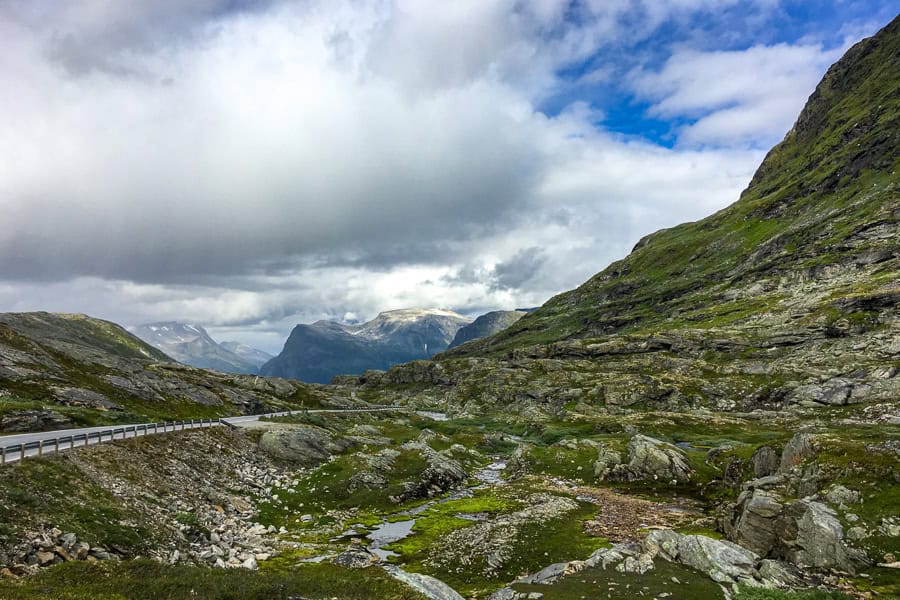
Car Rental in Norway
Unless you’re bringing your own car, you’ll need to hire a car for this Norway travel itinerary.
If your driving licence is in English, or uses Latin script it will likely be accepted by most car hire operators in Norway.
However, International Driving Permits are required from some nationalities so it’s advisable to check the booking terms and conditions with operators ahead of your visit.
We’ve always found the best deals at DiscoverCars and they’re our go-to car hire provider these days.
When we can, we always book well in advance to get the best rates and our preferred choice of vehicle. DiscoverCars offers free cancellation so if your plans change you can easily amend your booking.
Is Norway Expensive?
Everything you’ve heard is true: Norway is incredibly expensive. This naturally has implications for self-drive trips: petrol, parking, car ferries and road tolls all add up and need to be incorporated into your budget.
The benefit of a self-drive trip is that you do have options to economise if you wish. Camping, eating take-out, using supermarkets, and cooking your own meals will all save you money. As will not drinking alcohol or buying alcohol from supermarkets instead of drinking in pubs (an expensive experience we didn’t repeat very often).
Norway Road Trip Itinerary
Day 1 – Getting To Know Oslo
Highlights: Royal Palace | Slottsparken | Oslo Cathedral | Oslo Opera House | Akershus Fortress | Oslo City Hall | National Museum | Aker Brygge
Total driving distance: No driving today, you’ll pick up a hire car on day 3 of this itinerary.
Overnight: Oslo
As we only have 2 days in Oslo, we’re going to pack a fair bit into day one of our Norway itinerary. If possible, try to get a flight that arrives as early as possible to make the most of your time here. But don’t worry if you arrive a bit later, you can always do more tomorrow with an earlier start, or later finish, especially if you are visiting in summer when the days are much longer.
Oslo is a compact, cosmopolitan city of lovely waterways, green spaces, and interesting museums that certainly warrant a couple of days’ exploration. Once you’ve arrived and hotel formalities are sorted, head out to get acquainted with Norway’s bustling capital city.
There are a wide range options to help you explore Oslo’s main attractions, including walking, e-Scooter, bicycle, and bus tours.
We always try to jump on a walking tour when we are visiting a new city as it’s a great way to see the most famous sights and get insider tips on the best things to see and do. The popular two hour Guided Walking Tour in Central Oslo fits the bill for this perfectly.
If you want to fill your belly as you walk then consider the Street Food Culture Walking Tour, which spends a few hours feasting on street food while you explore Oslo’s riverside paths and street art.
Both tours get fabulous reviews and include free cancellation options should you need to change plans.
It’s also easy enough to spend a day exploring all the main sites on your own self-guided walking tour. Be sure to include the Royal Palace, Oslo Cathedral, the iconic Opera House, the Akershus Fortress, City Hall, National Museum and Aker Brygge on your wander.
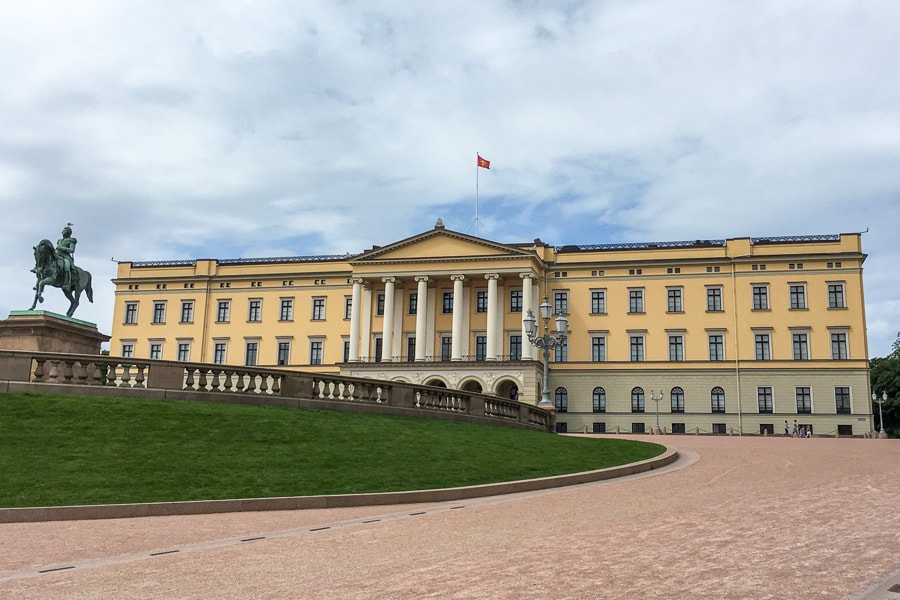
Detailed 2 Days in Oslo Itinerary
For a little more detail on getting the most out of your time in Oslo check out our suggested itinerary for two days in the city, which includes more information on daily activities and where to stay.
Where to Stay in Oslo
Oslo has plenty of accommodation choice, ranging from luxurious waterfront hotels to boutique B&Bs and campsites. Prices vary, and it’s advisable to book in advance during peak periods, typically in the summer months when tourism is at its height.
You’ll find accommodation scattered across, and beyond the city. Gamle (the old town), Sentrum (central Oslo) and Aker Brygge are great options if you want to be close to all the action. Bohemian Grünerløkka is a little further out but more than makes up for it with its oh-so-cool vibe and variety of eating and drinking choices. Upmarket Frogner and Majorstuen offer a quieter, more local vibe, but are still well located for most sites around Oslo.
We stayed just east of the centre at the Scandic Helsfyr, which had nice, comfortable rooms and puts on a pretty mean breakfast. There’s a metro less than ten minutes’ walk away that provides regular trips into the city centre. For road trippers, the big bonus is the hotel has free parking. Check out our 2 days in Oslo post for additional hotel suggestions.
Day 2 – Oslo’s Nautical and Sculptural Highlights
Highlights: Oslofjord Cruise | Bygdøy Peninsula | Kon-Tiki Museum | Vigeland Park
Total driving distance: No driving today, you’ll pick up a hire car on day 3 of this itinerary.
Overnight: Oslo
For our second day in Oslo we’re focusing more on Norway’s maritime heritage and taking the opportunity to get out and about on Oslo’s harbour, the fabulously photogenic Oslofjord.
Cruise Oslofjord
There are a bunch of ways to explore Oslofjord, including exploring independently using the Båtservice public ferries which were great fun to use.
If you want to learn more about Oslo and its maritime history there are plenty of guided cruises to choose from, including the popular Guided Oslofjord Cruise by Electric Boat which departs from Aker Brygge and spends two and a half hours cruising the fjord.
You can also enjoy a Dinner Cruise on Oslofjord if you want to experience the fjord and city skyline in the evening while enjoying a three-course dinner with optional wine.
Whatever you decide upon, schedule something in and then adjust the remainder of today’s Oslo itinerary to fit in around that.
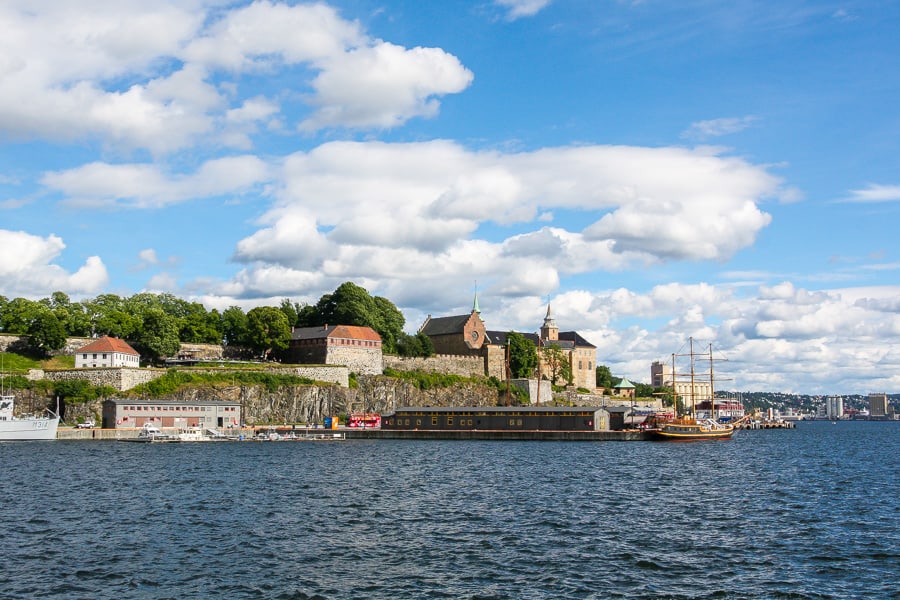
Bygdøy Peninsula
The Viking Ship Museum is normally the highlight of a visit to the Bygdøy peninsula, however it’s currently closed for a major renovation, and will reopen in 2027 as the Museum of the Viking Age.
In the meantime, there are still plenty of reasons to visit the Bygdøy Peninsula. In addition to the famed Viking ships, the peninsula hosts three other excellent maritime-themed museums. The peninsula can be reached by a very scenic ride on the Båtservice.
The Kon-Tiki Museum provides a fascinating insight into Thor Heyerdahl’s daring expeditions, including the famous Kon-Tiki raft voyage across the Pacific. The Fram Museum shares harrowing tales of polar exploration and allows guests to step aboard the world’s strongest wooden ship. Or learn about Norway’s maritime heritage from ancient seafaring traditions to modern maritime innovations at the Norwegian Maritime Museum.
Whether you visit one or all three museums, or just take a stroll along the peninsula’s scenic trails or check out its lovely beaches, Bygdøy certainly warrants a few hours in today’s itinerary.
Vigeland Park
The other significant stop we recommend today is a visit to Vigeland Park, probably our favourite green space in Oslo and the largest sculpture park in the world. The park can be reached on foot from the city if you don’t mind a half hour walk, or you can save your legs by getting tram 12 or the metro from central Oslo.

Home to more than 200 sculptures by artist Gustav Vigeland, the park is a testament to Vigeland’s life work and determination (or obsession). This incredible collection of bronze, iron and granite sculptures really seize the imagination. The works capture a range of human emotions, but be sure to keep your eyes peeled for the large central Monolith, the Angry Boy and the Wheel of Life, all of which are particularly striking.
Finish the day with a dinner cruise on Oslofjord or head to Aker Brygge, Sørenga, or Grünerløkka for a bite and a few drinks. Don’t overindulge though, it’s an early start tomorrow.
Day 3 – Oslo to Stavanger via the North Sea Road
Highlights: Risør | Lillesand | Kristiansand | Lindesnes Lighthouse | Flekkefjord | North Sea Road
Total driving distance: appx. 620km (385 miles)
Total driving time: appx. 8.5 hours
Overnight: Stavanger
Our Norway road trip hits the highway today with a very long drive. We recommend getting to the airport as early as you can so you can pick up your hire car and hit the road before traffic around Oslo gets too busy.
The fastest route to Stavanger from Oslo is around 600km via the E18 and E39 which takes between 7 and 8 hours to drive, depending on traffic.
It’s all highway, and to be completely honest, it’s not the most thrilling drive in the world. However, as we only have 2 weeks in Norway we’re keen to get stuck into the adventures that await in Stavanger and beyond, so recommend doing this leg of the journey in a single day.
If you’re visiting in summer and don’t mind arriving in Stavanger a little later, there are a handful of picturesque coastal towns along the route where you can choose to break up the journey with a walk along the beach or lunch.
Around 3 hours from Oslo you’ll pass Risør, and an hour further along, Lillesand. Both are good spots to stretch your legs with a wander through pretty old towns that have distinctive, white-painted houses and bustling waterfronts.
Our halfway point today is Kristiansand where you can grab lunch, enjoy a rest at one of the local beaches or have a walk through the colourful historic district of Posebyen. There’s a lively fish market here (Fiskebrygga) where there’s no shortage of choice if you’re feeling peckish.
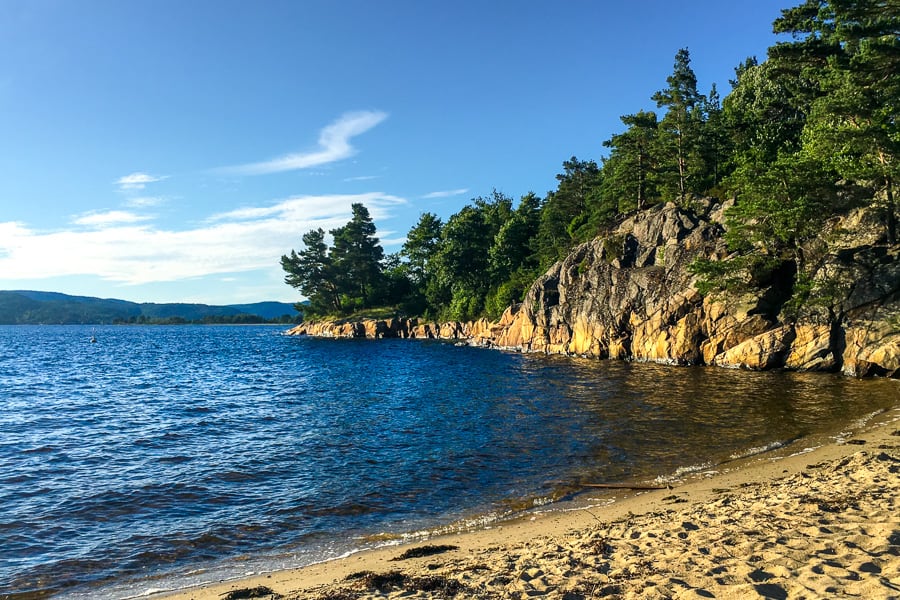
If you’re into lighthouses and coastal scenery, Lindesnes Lighthouse at the southernmost point of mainland Norway might be of interest. There’s also a fancy underwater restaurant here. Further west, Flekkefjord‘s Gamlebyen district is another old town of cobblestone streets and wooden houses that’s definitely worth exploring.
From Flekkefjord you can be in Stavanger in around 2 hours by continuing along the E39. However, if you’re going to take one diversion today, we’d recommend getting off the highway at this point to take the North Sea Road (the Rv44) between Flekkefjord and Sandnes.
While this will add a little over an hour to the journey, it’s probably the most scenic part of today’s drive, winding through wooded mountain roads, past beautiful coastal scenery, lovely beaches, cute traditional villages and fjords. It really is a lovely drive, just be prepared for lots of twists, turns and switchbacks.
After checking into your accommodation in Stavanger, finish the day with a stroll down to the waterfront in search of dinner. We were lucky enough to arrive just in time for sunset in the middle of a food festival. The harbourside was alive with people and delicious smells, the perfect way to end a very long day.
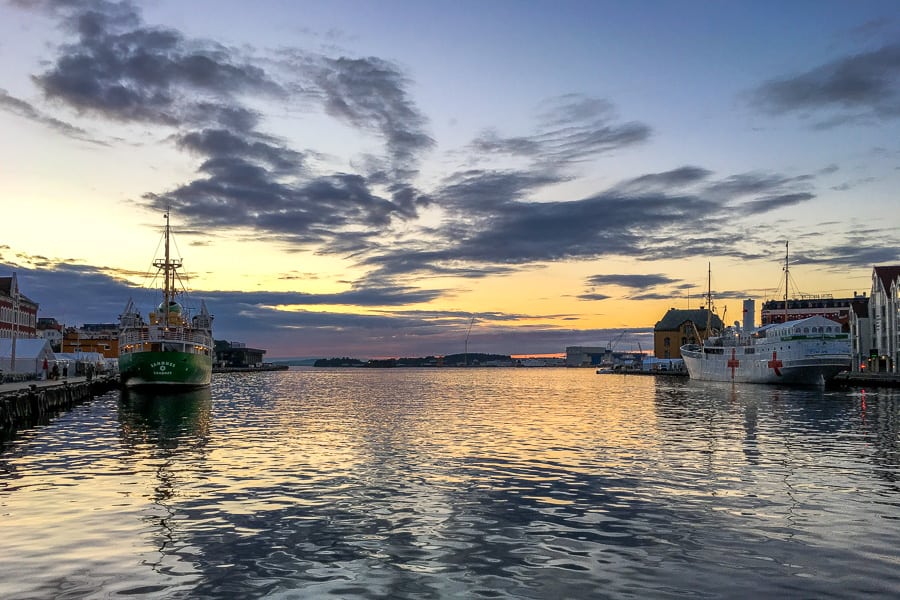
If you have more time and want to avoid a very long drive, pretty Kristiansand or one of the other coastal towns along this route make a nice overnight stop.
There’s also an inland route to Stavanger over the mountains via Telemark, Røldal and Ryfylke on the E134. It’s considered to be a more scenic drive that takes in mountains, lakes, waterfalls and stave churches. You’d need an additional day for this route though as the terrain means it takes a couple of hours longer to drive.
Another time-saving option would be to fly from Oslo to Stavanger and then get a rental car on a one way hire back to Oslo. Not only will this save you a very long drive, but it means you save a day so can add in one of the additional stops or activities we’ve highlighted in this post. Perhaps an extra day to kayak down the Nærøyfjord or an epic hike, like the one to Trolltunga: the options are limitless.
Where to Stay in Stavanger
As a popular university town, tourist centre, and a hub for Norway’s oil industry, it’s not surprising that Norway’s third largest city has plenty of accommodation on offer.
Whether you’re looking for somewhere in the cobbled streets of the old town, an upmarket joint along the picturesque harbour, or a quiet B&B in the residential back streets, it’s easy enough to find somewhere to stay in Stavanger within walking distance of the centre.
We stayed at Bjørvika Apartments – Sirkus Renaa, located an easy 10-15 minute walk from central Stavanger, with paid parking in a large facility adjacent to the hotel (organised in advance through the hotel). We had a studio room which was nice and clean, had a comfy bed, and was generally very well appointed. There are a range of apartments to choose from, including studios, 1 and 2 bedrooms. All have a fridge and small kitchenette.
The following options don’t have parking but get consistently good reviews:
- Good value: Cozee Central Apartments – clean and tidy apartment | central location | comfy bed | well equipped kitchen
- Mid-range: Radisson Blu Atlantic Hotel – central location | gym and sauna facilities | clean, modern rooms
- Indulge: Hotel Victoria – central harbourside location | spacious rooms | tasty breakfast | friendly staff
Parking in Stavanger
Unfortunately, most hotels we looked at in Stavanger didn’t provide parking, so the choices are to use paid parking garages, or find street parking.Just beware some residential areas are for permit holders only, so if you’re unsure where to park, check Parkopedia, ask a local for advice, or check with your hotel before you arrive.
Day 4 – Hiking Pulpit Rock and Exploring Stavanger
Highlights: Hiking Pulpit Rock | Stavanger Cathedral | Gamle Stavanger | Øvre Holmegate
Total driving distance: appx. 80km (50 miles)
Total driving time: appx. 1.5 hours
Overnight: Stavanger
Hit the road early today with a 45-minute drive to the Prekistolen (Pulpit Rock) car park via the longest subsea road tunnel in the world, the 14.4 kilometre Ryfylke tunnel.
Pulpit Rock Parking – It’s advisable to arrive at the car park as early as you can (6am or 7am), especially in the summer months, to ensure you get a car space. We made the mistake of a later arrival on our first attempt and had to postpone our hike due to lack of parking.
An early start will also let you enjoy the trail before it gets too hot and crowded, as well as allowing enough time to get back to Stavanger for an afternoon exploration of the city. Believe me, you’ll be grateful for the early start when you’re coming down and see the crowds making their way up.
The hike is just shy of 8km and is considered moderately difficult. There are certainly some lung-busting ascents, and it definitely challenges your knees and ankles in places. We took our time, had lots of breaks, and managed the hike in around 2 hours each way.
After getting to the top and being absolutely blown away by the scenery, we climbed a little further until we found a rocky outcrop with stunning views over Pulpit Rock and across Lysefjord. This turned out to be the perfect spot to recover from the hike up and enjoy a very well-earned breakfast.
For a little more detail on our experience of this hike, check out our Hiking to Pulpit Rock post.
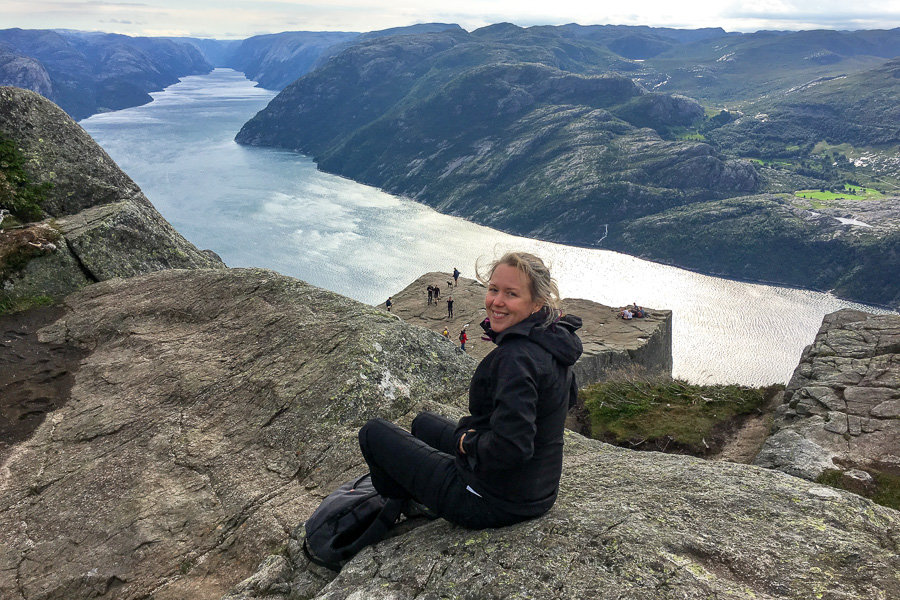
If you’d prefer to have the experience organised for you and hike with an experienced guide the Pulpit Rock Guided Hike with Pickup from Stavanger gets great reviews.
And of course, if you want to see Pulpit Rock, but don’t want to sweat your way up to the top, you can always opt for a more relaxing cruise to Lysefjord and Preikestolen from Stavanger.
After returning to Stavanger and freshening up, head out to the old town, Gamle Stavanger, and choose a spot for lunch before embarking on an afternoon wander.
The central part of the city is nice and compact, and easily walkable in an afternoon. Highlights of Gamle Stavanger include its cobbled streets and 18th century traditional wooden houses, an imposing medieval cathedral, and Stavanger’s most popular street, Øvre Holmegate with its busy vibe and jumble of colourful wooden houses, many of which are now cafes, bars or shops.
Grab some dinner and get an early night as it’s another energetic day tomorrow.
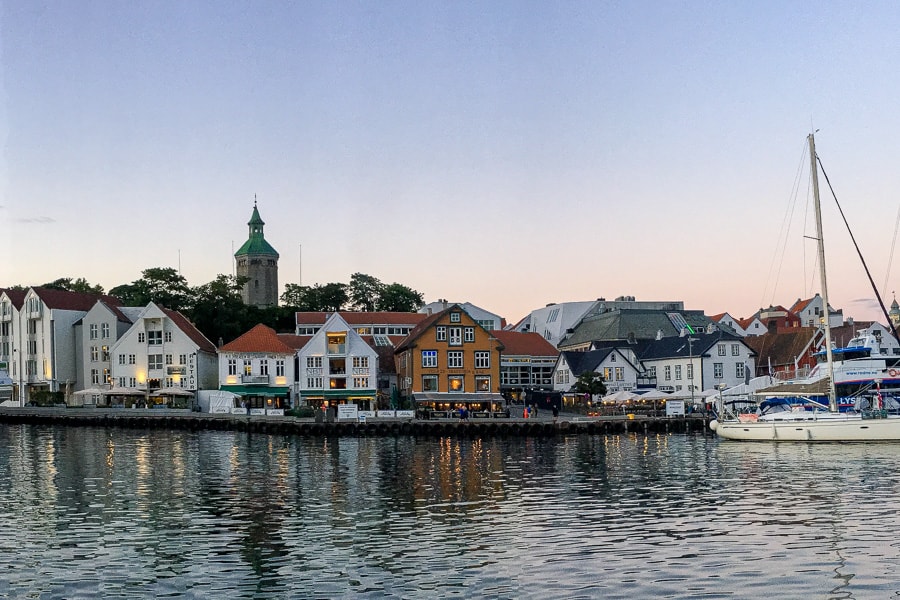
Day 5 – Hiking Kjerag
Highlights: Cruising the Lysefjord | Kjerag Hike | Scenic drive along the Fv500 and Fv450
Total travel distance: appx. 230km (143 miles)
Total travel time: appx. 6 hours 15 mins
Included ferry crossing: Lauvvik-Lysebotn
Overnight: Stavanger
Today might just be the most thrilling day of our entire Norway road trip itinerary, so strap yourself in for the iconic Kjeragbolten (Kjerag Boulder) hike.
We’re at risk of becoming morning people with yet another early start today. It’s a 40-minute drive from Stavanger to Lauvvik to get a pre-booked 6:30am car ferry to Lysebotn.
Important information regarding the Lauvvik to Lysebotn car ferry
The car ferry needs to be booked in advance. It doesn’t operate every day, and when it does there is only one morning crossing.Be sure to check the ferry timetable ahead of time as part of your itinerary planning. More information, including timetable and booking links can be found on the Visit Norway website.
Once on the ferry, settle in for a truly spectacular two-and-a-half-hour cruise along the length of Lysefjord, undoubtedly one of the most beautiful fjords in Norway.
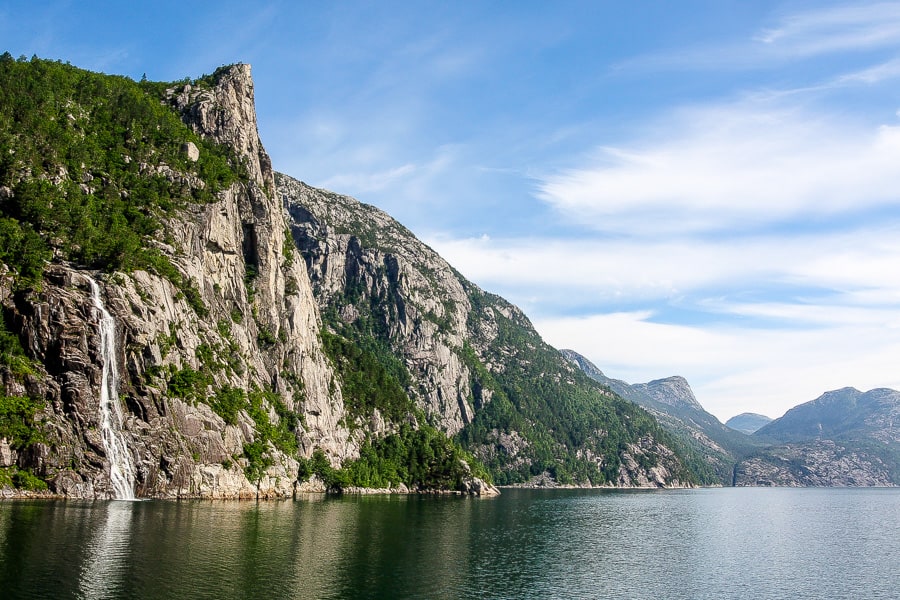
From the ferry it’s a fun, if slightly white-knuckle drive up the side of the mountain along the switchbacks of Lysevegen Road to get to the Kjerag carpark, where you’ll pay a hefty NOK300 to park for the day (although it’s only fair to note parking fees do fund the tourist facilities in this remote corner of Norway).
I won’t sugar coat it, we found the hike pretty tough. It’s steep and slippery in places, and sometimes you need to use chains to drag yourself up the slopes. But your reward for all that hard work is the incredible view across Lysefjord and, if you can keep your nerve, and stop your legs wobbling long enough, that iconic pic standing on Kjeragbolten 984 metres above the fjord.
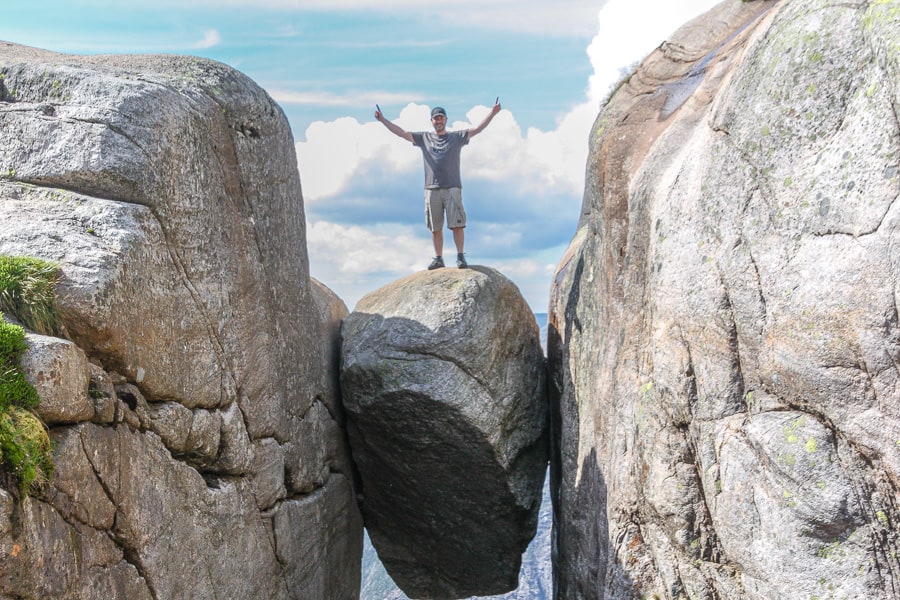
All up the hike (around 10km return) took us about 6 hours, including taking a breather up top, and queuing to get onto the boulder. We’ve written more about the experience in our Hiking Kjerag post.
After the hike, loop back to Stavanger via the Fv500 and Fv450, an incredibly scenic 2.5 hour (140km) drive through the very heart of fjord country.
Weather Warning: Like many hikes in Norway, Kjerag should only be tackled between June and September. Outside of hiking season the trail is too dangerous and the road to Kjerag is closed.
Day 6 – Stavanger to Bergen
Highlights: Bergen Fish Market | Bryggen Wharf | Fløyen Funicular
Total travel distance: appx. 210km (130 miles)
Total travel time: appx. 5 hours
Included ferry crossings: Mortavika-Arsvågen | Halhjem-Sandvikvåg
Overnight: Bergen
The scenic drive between Stavanger and Bergen is a little over 200km but takes more than five hours. Around 30km of the journey is by car ferry, so you’ll need to factor in extra time for the two ferry crossings as you weave your way through spectacular fjord-and-mountain landscapes.
If you’re like us, stopping for photos every five minutes will also slow your progress, in the best possible way of course.
A couple of hours into the drive you’ll pass the town of Haugesund. If you need a break, you’ll find Norway’s national monument, Haraldshaugen, here. It’s said to be located on the site Harald Fairhair is buried. There’s also a thousand-year-old stone cross nearby and, if you want to stretch your legs, the Kyststien trail runs along the coastline here.
Bergen is an attractive, walkable city with a bustling waterfront area. After checking in to your hotel, head down to Bergen’s famous Fish Market and grab a late seafood lunch. Spend the afternoon exploring the city and the atmospheric Bryggen Wharf area, a colourful World Heritage-listed nod to the city’s Hanseatic past.
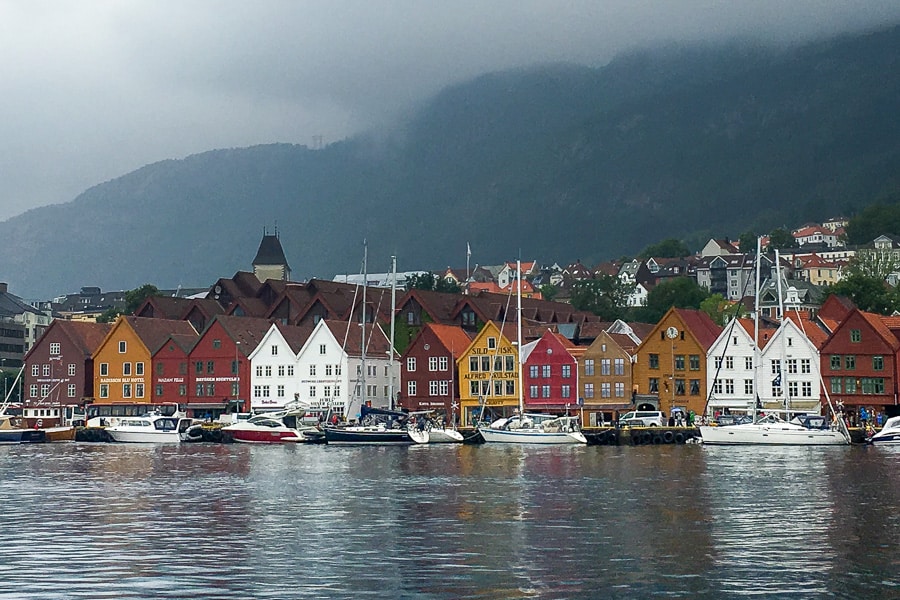
If you’d like to learn a bit more about Bergan’s history and culture on a locally owned and operated walking tour then try the Past & Present Small Group Guided Walking Tour, it covers all the main spots and gets great reviews.
For panoramic views of the city and surrounding fjords, take the funicular up to Mount Fløyen.
Surrounded by mountains, rain makes a regular appearance in Bergen and we weren’t spared on our visit. Just as we emerged from the funicular at the top of Fløyen, the clouds rolled in and drenched us with rain. Even so, the views of city and harbour that we were able to glimpse through the mists were truly spectacular. Bring wet weather gear just in case.
Where to Stay in Bergen
Bergen is Norway’s second largest city and has a busier feel about it. If you want to be near the main points of interest, look for accommodation around Sentrum and Bryggen. However, there are also plenty of accommodation options further out, including towards the airport located around 18km from the centre of town.
We stayed at the Quality Hotel Edvard Grieg near the airport as we managed to get a good deal on the room which included free parking (we understand they have since started charging). The hotel is comfortable and modern, has a decent car park, and is an easy 20 minute drive to the city.
If you want to be closer to the action, the following options get consistently good reviews:
- Good value: City Hostel Bergen – clean rooms | 5 minute walk to the harbour | good shared kitchen
- Mid-range: Citybox Bergen City – simple modern rooms | close to train station | 15 minute walk to the harbour
- Indulge: Radisson Blu Royal Hotel – lovely modern hotel | great location at Bryggen Wharf | parking garage (paid)
Day 7 – Bergen to Gudvangen and a Nærøyfjord Kayak Trip
Highlights: Nærøyfjord Kayak Trip
Total driving distance: appx. 150km (93 miles)
Total driving time: appx. 2.5 hours
Overnight: Gudvangen (or nearby)
We’re now firmly in the heart of fjord country, and the outdoor adventures continue today with a journey to the fjord-side village of Gudvangen. From here we’re embarking on a memorable guided kayaking trip along the World Heritage-listed Nærøyfjord.
Our paddle started at 10am, so you’ll need to be on the road early from Bergen for the two-and-a-half hour drive past lakes, waterfalls, and increasingly beautiful mountain and fjord scenery.
It probably won’t come as much of a surprise that to earn its UNESCO recognition, Nærøyfjord is a bit of a stunner, and there’s nothing quite like seeing it from a sea kayak.
Imagine gently paddling along in almost perfect silence, surrounded by immense rocky mountain slopes that enclose you the deeper into the fjord you go, past raging waterfalls, lush green valleys, and tiny villages. There’s a tranquillity to it that’s hard to describe, and it’s an experience we’ll be talking about for many years to come.
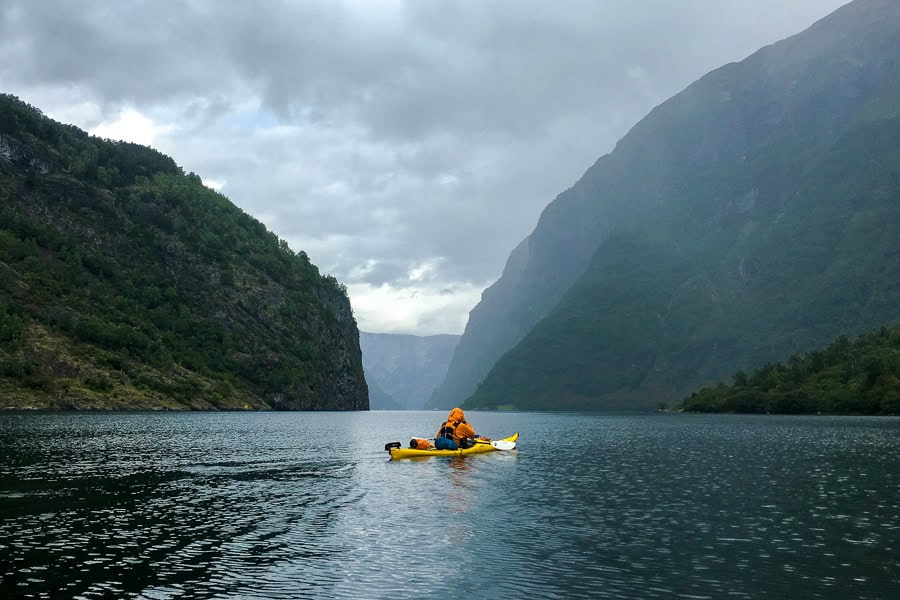
Half-day and full-day kayak trips typically include a barbecue-style lunch and return to where you started from in Gudvangen, while multi-day trips finish further into the fjords (our two-day trip ended at Undredal on Aurlandsfjord). If you have more time available we’d highly recommended a longer paddle. Check out our kayaking the Nærøyfjord post for more details about what to expect.
We booked our tour directly with Nordic Ventures, but if you have less time, you can also book a Nærøyfjord Full-Day Guided Kayaking Trip from Vossevangen through GetYourGuide.
If you’re feeling less energetic a variety of cruises operate from Gudvangen, Flåm, Aurland and Undredal. More details are available on the Visit Norway website.
Where to Stay in Gudvangen
While it’s a key gateway to Nærøyfjord, the village of Gudvangen is quite small, so accommodation choices are limited. Broadening your search to include the wider Aurland region, including Bakka, Flåm, Aurland and Undredal will give you more options.
The following options around Aurland get consistently good reviews:
- Good value: Winjum Hostel Stegastein – clean comfy rooms | well-appointed shared kitchen | fabulous view from terrace
- Mid-Range: Svingen Guesthouse – cosy rooms | spotless shared kitchen and bathrooms | fjord views
- Indulge: Gudvangen Fjordtell – perfect fjordside location | on-site seafood restaurant | comfortable Viking themed rooms
We opted to camp at picturesque Lunde Camping. It’s a friendly place set beside a river near to the small town of Aurland where you’ll find a few shops and a supermarket. The campsite has plenty of space for tents, but there are also simple, modern chalets for non-campers, which include bunks and a kitchenette.
Day 8 – Gudvangen to Sogndal via Flåm
Highlights: Stegastein Viewpoint | Flåm | Flåmsbana Railway | Borgund Stave Church | Aurlandsfjellet Scenic Route | Kaupanger Stave Church
Total travel distance: appx. 165km (103 miles)
Total travel time: appx. 3 hours 15 mins
Included ferry crossings: Mannheller-Fodnes
Overnight: Sogndal
You’ve probably earned an extra hour in bed this morning, but when you’re ready, jump in the car and head towards the popular town of Flåm, an easy 20 minute drive from Gudvangen.
If the weather is good, bypass the town centre for now and head straight up the very steep and winding “Snow Road” to the Stegastein Viewpoint. Jutting out 30 metres from the mountainside, the platform provides a truly spectacular birds-eye viewpoint from its position 650 metres above Aurlandsfjord.
Get ready for the crowds
Flåm gets inundated with visitors during peak season. Not only does it have the famous Flåmsbana railway, but it’s also a hub for day trips to Aurlandsfjord and Nærøyfjord, as well as being a major stop for cruise ships.If you are visiting at peak time, it’s best to book any activities well ahead of time, and if you can, try to avoid being here on days when the biggest cruise ships are docked. The Flam Port website has information on cruise ship arrivals, including the number of passengers on each ship.
While we’re not fully convinced it lives up to the label of ‘best train ride in the world’, the Flåmsbana railway feels like one of those things you need to tick off the list while visiting the western fjords.
It’s a 20km, hour-long ride from Flåm to Myrdal station, 867 metres above the fjord. As you rise into the mountainside, past waterfalls and valleys, the gradient gets ever steeper and the views become more impressive. The journey includes brief stops at the raging Kjosfossen waterfall and Myrdal station before you head back down.
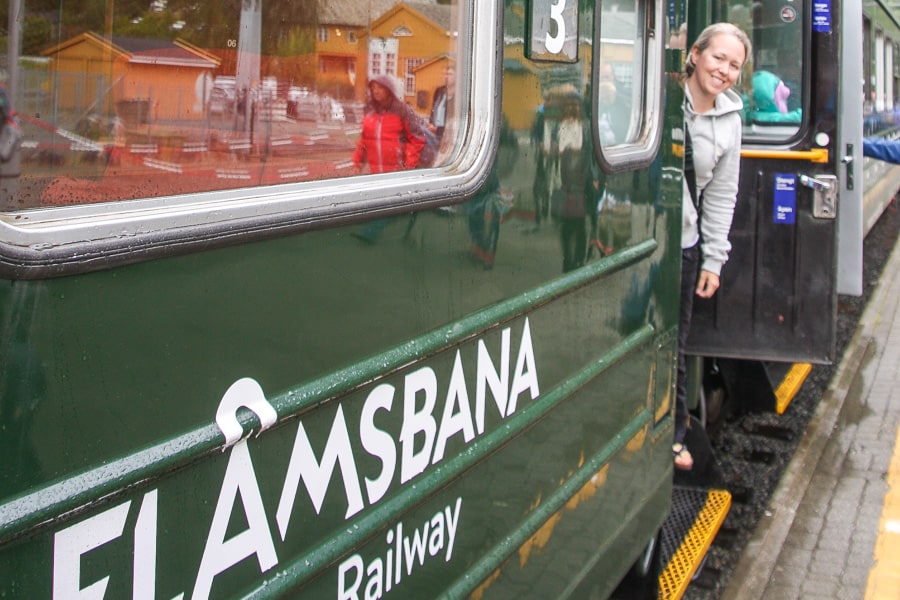
After the train ride, stretch your legs with a walk around Flåm while enjoying the views down the fjord. There are some lovely traditional wooden buildings, a free railway museum, a church dating back to 1670, and if you’re feeling active, bike riding or Scandinavia’s longest zipline. If you’re in need of a break and some refreshment, the brewpub and bakery are popular spots in town.
After Flåm, our journey heads past the town of Aurland before joining the Aurlandsfjellet Scenic Route and taking a 24.5 kilometre journey through the inside of the mountain via Lærdalstunnelen, the world’s longest road tunnel.
If you have time and are interested in seeing one of Norway’s best preserved medieval stave churches, it’s only a 20 minute drive from the end of the tunnel to Borgund Stave Church.
From here it’s a little over an hour to Sogndal via the Rv5 and Mannheller-Fodnes car ferry. The road passes close to Kaupanger Stave Church around ten minutes before you get to Sogndal.
What’s a stave church?
Stave churches are medieval timber churches that were built using a unique style of load bearing wooden frame with four corner posts, or staves.Constructed entirely from wood, the churches are distinctively designed with intricate multi-tiered high roofs and beautiful woodwork.
There were once more than a thousand of these churches in Norway, but today, only 28 remain.
Where to Stay in Sogndal
There are a handful of villages and towns in the Sogndal area offering accommodation around the Sognefjord, including Sogndal, Hermansverk, Hafslo, and Kaupanger.
While these towns aren’t overflowing with accommodation, there’s enough choice to suit most needs, including hotels, bed and breakfasts, holiday homes, apartments, hostels, and camping. The following options get consistently good reviews:
- Good value: Nedre Amla Fjord Apartment – cosy apartment | fjord views | free parking
- Mid-range: Best Western Laegreid Hotell – large rooms | comfy beds | centre of Sogndal
- Indulge: Hofslund Fjord Hotel – fjord views | heated pool | comfy rooms | free parking
We stayed at Sogndal Bed & Breakfast, a summer hostel offering budget rooms close to Sogndal village. While certainly not luxurious, the B&B has large, clean, modern rooms with comfy beds, free parking, and breakfast included in the price. It’s also a really convenient base for visiting nearby Austdalsbreen Glacier.
Day 9 – Austdalsbreen Glacier
Highlights: Austdalsbreen Glacier Kayaking and Hiking
Total driving distance: appx. 163km (100 miles)
Total driving time: appx. 3 hours
Overnight: Sogndal
Today encapsulates everything we love about road tripping, with a truly spectacular drive, followed by one of the most memorable adventures of this Norway itinerary.
The day starts with an hour-long drive to Breheimsenteret Glacier Centre to meet up with the team from IceTroll who will be taking us on a trip to Austdalsbreen glacier.
Arrive early if you can as the centre (open from May to early October) has incredible views of nearby Nigardsbreen glacier and provides an interesting introduction to the world of glaciers, and both Jostedalsbreen and Breheimen national parks.
There’s something surreal and truly awe-inspiring about paddling across the pristine waters of Styggevatnet glacier lake towards Austdalsbreen glacier. And getting to walk on the glacier itself remains one of our all-time favourite travel memories. This tour runs between July and September. You can find a more detailed write up of our experience in our post about exploring Austdalsbreen glacier.
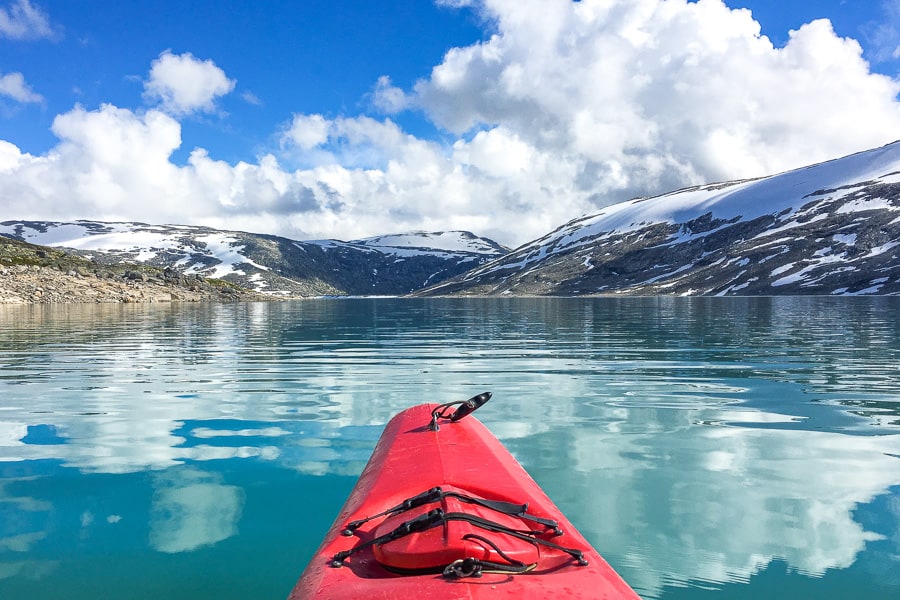
If you’re anything like us you’ll be buzzing on the drive back to Sogndal, but remember to take in the beautiful scenery on the way, and maybe treat yourself to a beer (and perhaps dinner) overlooking the fjord at Dampskipskaien Café when you get back to town.
Day 10 – Sogndal to Geiranger
Highlights: Most Spectacular Drive in the World | Geirangerfjord | Ørnesvingen Viewpoint
Total driving distance: appx. 220km (137 miles)
Total driving time: appx. 4 hours
Overnight: Geiranger
If yesterday’s glacier excitement wasn’t enough, you’re in for another real treat today, as you take on the most spectacular drive in the world. It’s a huge call I know, but it’s certainly among the most incredible stretches of tarmac we’ve ever driven and an absolute highlight of this 2 week Norway itinerary.
It’s another experience we’ve written about separately, so check out our Sogndal to Geiranger blog post for more details and lots of pics.
Please note some sections of this drive should be considered weather dependent. If you are thinking of attempting this route outside of the summer months, or in poor weather, check road conditions and closures before setting off.
The drive takes you out of Sogndal along the Rv5, E39, Rv15 and Rv63 all the way to Geiranger. While it’s only 220 kilometres, you should plan to make a day of it as it’s one of those drives that will have you pulling over every few minutes to marvel at the scenery.
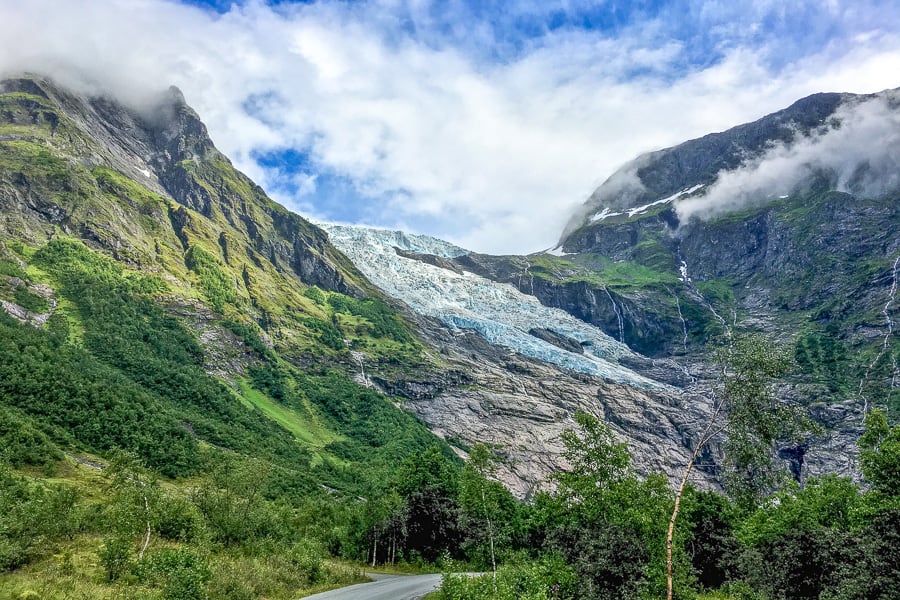
The drive takes you past fjords, snow-capped mountains, glaciers, lush valleys, quaint Norwegian villages, tranquil lakes, and more waterfalls than you could poke a stick at. Labelling it as ‘jaw-dropping’ feels like a bit of an understatement.
You’ll probably have run out of superlatives by the time you get your first glimpse of Geiranger, but try to muster one last bit of energy for the 15 minute drive alongside Geirangerfjord and up what feels like endless switchbacks of ‘Eagle Road’ to reach Ørnesvingen Viewpoint.
Taking in the views across the World Heritage-listed Geirangerfjord from here is a fitting way to end the ‘most spectacular drive in the world’ before checking into your Geiranger accommodation and seeking out some well-deserved dinner.
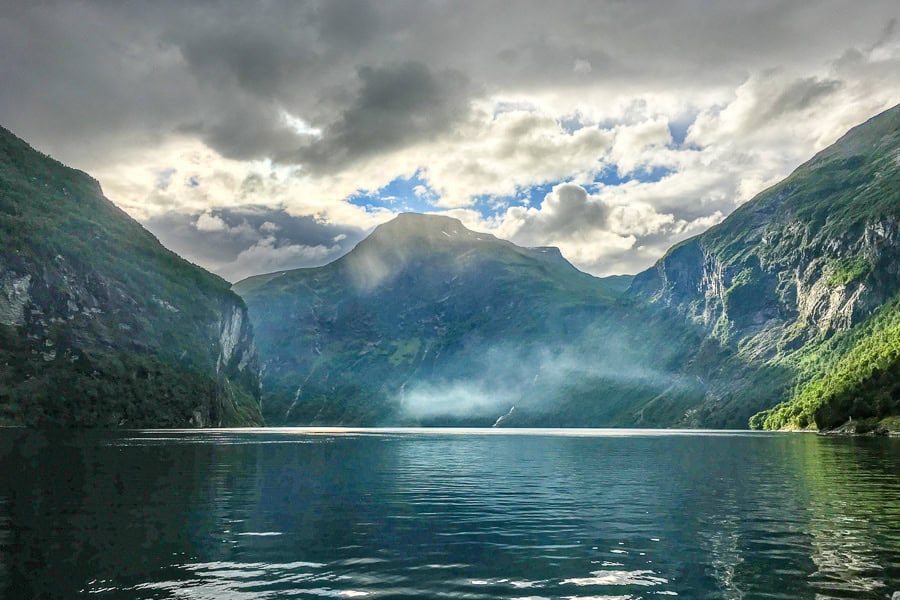
Where to Stay in Geiranger
The fjord-side village of Geiranger gets top points for dramatic positioning, although as a popular destination for day-trippers, cruise ships and holidaymakers, it’s probably the busiest place we encountered outside of Norway’s cities.
Despite its popularity, Geiranger is very small, and there’s only a handful of accommodation options available. It’s advisable to book your stay well in advance, especially during peak periods when demand surges. The following options get consistently good reviews:
- Good value: Lunheim in Geiranger– cosy apartment | fabulous views over Geiranger | friendly host
- Mid-range: Vinje Camping – comfortable cottages |kitchenette | fjord views
- Indulge: Grande Fjord Hotel – fabulous views | comfy clean rooms | relaxing hot tubs | free parking
We pitched a tent at Grande Hytteutleige og Camping, set in a spectacular location right on the fjord a couple of kilometres from town. Shared cooking and bathroom facilities were decent, and staff were extremely friendly and helpful. Cabins with ensuite bathrooms and private cooking facilities are also available to rent.
Day 11 – Geiranger to Alesund
Highlights: Hellesylt | Alesund’s Art Nouveau Architecture
Total travel distance: appx. 110km (68 miles)
Total travel time: appx. 3.5 hours
Included ferry crossings: Geiranger-Hellesylt | Magerholm-Ørsneset
Overnight: Alesund
As one of most beautiful fjords in Norway, you won’t be surprised to learn Geiranger has plenty to keep you busy if you have time to stay a little longer. Tourist cruises loop the fjord several times each day, and for the more active, there are kayaking, biking, ziplining and hiking excursions to be enjoyed.
If we’d had more time we would certainly have considered jumping on a guided boat tour on the fjord, or perhaps a scenic bus tour in the region, or even a kayak trip. All of the tours below get great reviews and are well worth considering if you have more time.
As we only have 2 weeks in Norway on this itinerary, we’re combining travel and sightseeing by enjoying Geirangerfjord from the car ferry. It’s a spectacular journey, travelling the length of the fjord and then continuing on to the village of Hellesylt.
From here, it’s time to get back on the road and head north west towards the coastal town of Alesund. The road from Hellesylt skirts Geirangerfjord along the Fv60 offering up wonderful views along the way. If you want some pics keep your eyes peeled for the Geiranger Fjord Viewpoint, around 6km from Hellesylt, it’s one of the many spectacular viewpoints you’ll pass on today’s drive.
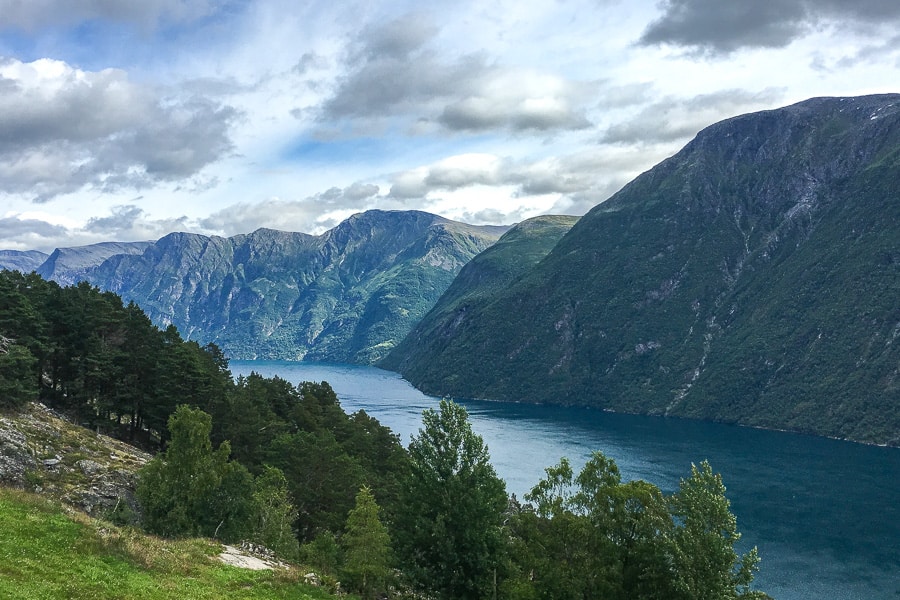
You could easily spend a couple of days enjoying Alesund and the surrounding areas so try to arrive in good time to allow at least half a day to enjoy this pretty port town.
Bypass Alesund for now though and drive straight to Godøy island. If you’re feeling energetic, there are a few hikes to enjoy here, the shortest of which would be the two-and-a-half hour (3.5km), out and back, moderately challenging trail to Storhornet. At the peak you can enjoy a well-earned rest while you appreciate the 360-degree panorama of the surrounding islands and Alesund. Seek out the 1876 Alnes lighthouse before heading back to Alesund and checking in to your hotel.
Considered by many to be Norway’s most beautiful town, Alesund’s pastel-coloured centre is the result of a near-total rebuild in the early years of the 20th century, after a great fire burnt down most of the city. It’s a great place to spend a couple of hours, strolling through the cobbled streets and around the waterfront to really appreciate the wonderful art nouveau architecture. If you’re interested in delving a little deeper, the Art Nouveau Centre provides a more in-depth understanding of Alesund’s architecture and history.
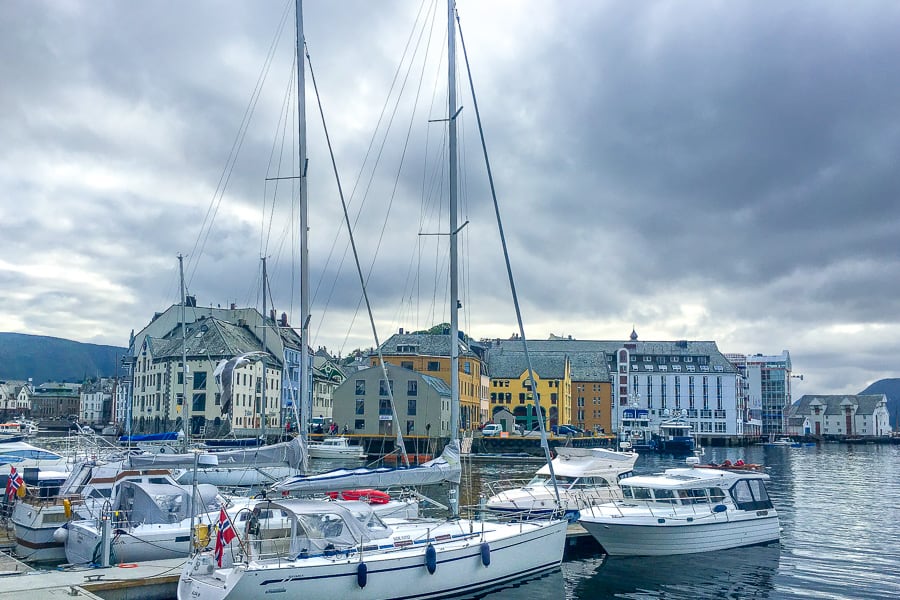
There are a variety of other things to do in and around Alesund depending on your interests and available time.
The city sightseeing bus gets decent reviews and takes in many of the major points of interest, including the fisheries museum, the Atlantic Sea Park (3km out of town), and a small penguin colony.
If you’re feeling more energetic and want to see Alesund from the water, the Sea Kayaking In Ålesund tour offers a unique opportunity to explore Alesund’s waterways in a small group that caters for all levels of experience.
Whatever you decide, it’s worth ending the day by enjoying freshly caught local seafood at one of the many good restaurants around town.
Where to Stay in Alesund
There’s a decent variety of accommodation options in and around Alesund, from camping to apartments, guesthouses, homestays and hotels. The following options get consistently good reviews:
- Good value: Kirkgate 4 – comfy homestay | central location | shared bathroom | paid parking
- Mid-range: Quality Hotel Waterfront – clean and modern | central location | waterfront | on-site restaurant and bar
- Indulge: Hotel 1904 – stylish hotel | comfortable rooms | central location | great staff
We stayed at centrally located Thon Hotel, which was close to everything and has a small guest car park, as well as being near a larger public car park. Rooms were large, clean and very well appointed with all the facilities you’d expect. Rates include a decent breakfast with a good selection of hot and cold food.
Day 12 – Alesund to Trondheim via the Atlantic Road
Highlights: Aksla Viewpoint over Alesund | Atlantic Road
Total travel distance: appx. 360km (224 miles)
Total travel time: appx. 7 hours
Included ferry crossings: Molde-Vestnes | Halsa-Kanestraum
Overnight: Trondheim
It’s a big driving day today, so we’d recommend starting early with a quick drive up the mountain behind Alesund to the Aksla Viewpoint. From here the panoramas of Alesund, the Sunnmøre Alps, and surrounding area are absolutely fantastic (keen walkers can hike to the viewpoint).
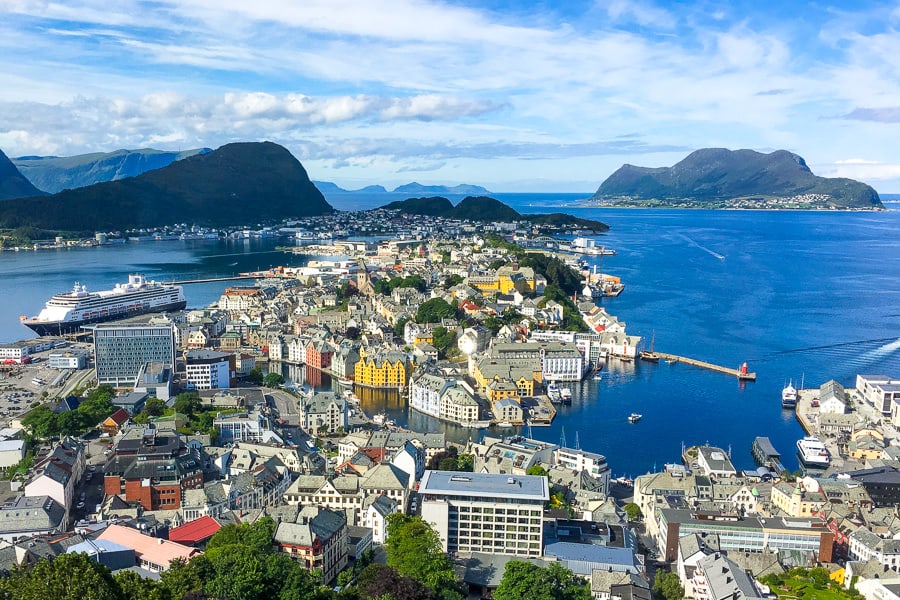
Rather than take the most direct route to Trondheim we suggest taking a slight detour that includes a stint along the famous Atlantic Ocean Road.
This is a picturesque stretch of causeways, bridges and highway linking the many islands of the region’s archipelago. It makes for a longer day, but it’s well worth it.
While the whole drive to Trondheim is beautiful in itself, the Atlantic Ocean Road, one Norway’s eighteen recognised scenic routes, is really the highlight and the focal point of the day.
Funny enough, it’s a road that might never have come into being if the 1909 plans for a railway along this route had been realised. It took another 26 years for Parliament to approve a road project instead, and then a further 48 years before the six-year road construction project actually began in 1983.
The culmination of all this is one of the world’s great drives. It’s an engineering marvel that winds through the stunningly beautiful, rugged coastline with the vast ocean as a backdrop, and the relentless North Atlantic weather as a constant reminder of the powerful natural forces that shape the land here.
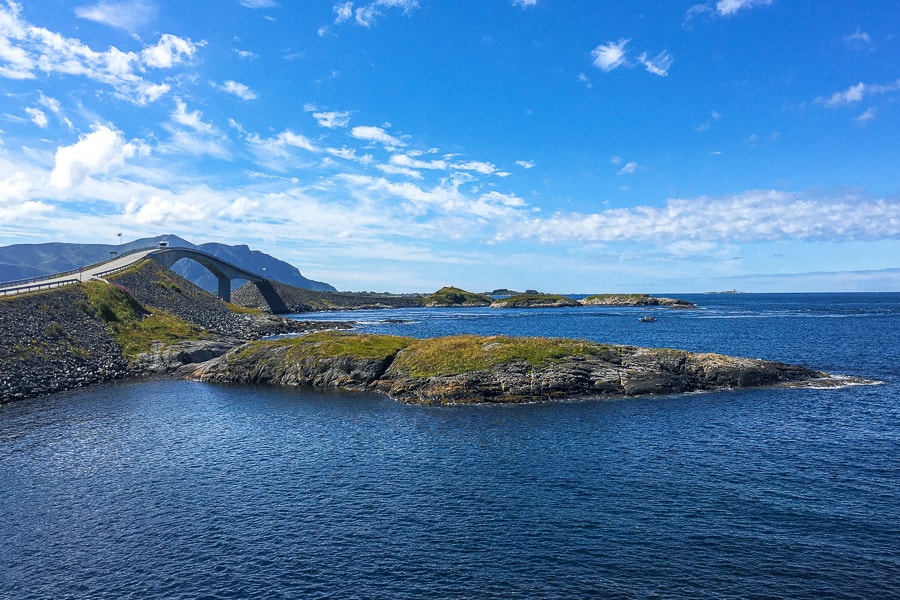
There are a few spots along the way to pull off the road and take in the views, most notably at the southern end of Eldhusøya island, just after the iconic Storseisundet bridge. You’ll find plenty of parking here, along with toilets and a café.
A little further north, Kristiansund marks the halfway point of today’s trip. It’s a good spot to stretch your legs and grab some lunch, especially since it’s a town famous for ‘fishan’ (fish and chips to you and me). It’s around three-and-a-half hours to Trondheim from here.
As it’s been a long day, we’ll leave the Trondheim sightseeing until tomorrow. Just drop off your bags and head into town for dinner.
Trondheim is a vibrant university town with a reputation for being a bit of a foodie destination, so there’s no shortage of places to eat and drink, from casual to Michelin star eateries.
Where to Stay in Trondheim
As one of Norway’s largest cities, it’s unsurprising that Trondheim has a decent range of accommodation in and around the city centre, Bakklandet and Solsiden that would meet most needs. If we had one gripe, it’s that generally parking was quite expensive.
We stayed at the Scandic Solsiden, located in a nice area with a laid-back vibe and lots of waterside dining and drinking options. It’s only around a ten minute walk into the centre of town, has on-site parking (paid), and is also close to a couple of parking garages. The room, service and varied breakfast were all great, and overall we felt it was a solid choice for Trondheim.
Other options that get consistently good reviews include:
- Good value: Pilegrimsgården Hotell og Gjestegård – clean and quiet | close to the cathedral | on-site parking (paid)
- Mid-range: Scandic Bakklandet– great central location | comfy rooms | yummy breakfast
- Indulge: Britannia Hotel – central location | stylish cosy rooms | attentive staff | spa and wellness centre | Michelin star restaurant
Day 13 – Trondheim
Highlights: Solsiden | Bakklandet | Gamle Bybro (Old Town Bridge) | Kristiansten Fortress | Nidaros Cathedral | Archbishop’s Palace | Stiftsgården
Total driving distance: No driving today.
Overnight: Trondheim
Once the capital of Norway during the Viking Era, Trondheim is a city with a long history. It’s rich cultural heritage stretches back more than a thousand years to when the city was founded by King Olav Tryggvason in the year 997.
It’s a city defined by its royal heritage, position as a trading outpost, proximity to Sweden, and also by the many fires that have quite literally shaped and reshaped it.
Today you’ll find a modern, trendy vibrant place where around a quarter of the population are students. Aside from being a city with a deep-rooted history, it’s also a centre of art, music, technology, culture and gastronomy.
Enjoy a rare car-free day today to explore this very walkable city. We highly recommend strapping on your sneakers and spending the day pounding the pavements.
While it’s certainly a city you can explore independently, there are also good options for guided walking tours here, with the Trondheim Like a Local Tour getting decent reviews for their customised private walking tours lasting anywhere between two and six hours.
Our Suggested Trondheim Self-Guided Walking Tour
As we were staying in the area, we started our day with coffee and a wander around Solsiden, a former shipyard that has been regenerated into a lovely modern waterside precinct. It’s also a great spot for dinner or drinks later on.
If you’re interested in Norwegian music, the Rockheim Museum is only 15 minutes’ walk from here. Otherwise continue your stroll (again just 15 minutes) to Bakklandet, Trondheim’s colourful old town. It sits photogenically aside the Nidelva River, with distinctive colourful houses and cobbled streets.
Spend a bit of time wandering the streets of Bakklandet to really appreciate the architecture and viewpoints along the canal, being sure to check out Gamle Bybro, Trondheim’s iconic Old Town Bridge.
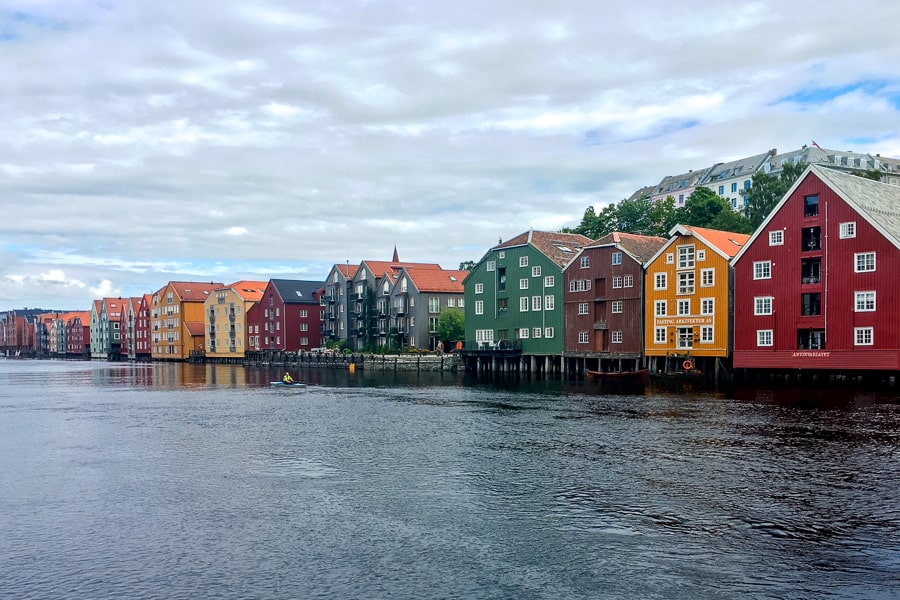
From here, it’s a steady 15-minute or so climb up to Kristiansten Fortress. Keep an eye out for the Trampe bicycle lift on your way, it’s quite a sight to watch people try, and sometimes fail, to use it (if you’re lucky and it’s in operation). The fortress and grounds are a popular spot for picnics in better weather and it’s the best place in town for spectacular views over the city towards the cathedral.
Head back down the hill and recharge your batteries with lunch somewhere in Bakklandet before crossing Gamle Bybro and heading to Nidaros Cathedral, an absolute highlight of visiting Trondheim.
Plan to spend some time here admiring this 11th century gothic masterpiece, with its ornate carving and statues, striking rose window and atmospheric crypt. During summer, the tower can be climbed for spectacular views over the city, and guided tours are also available.
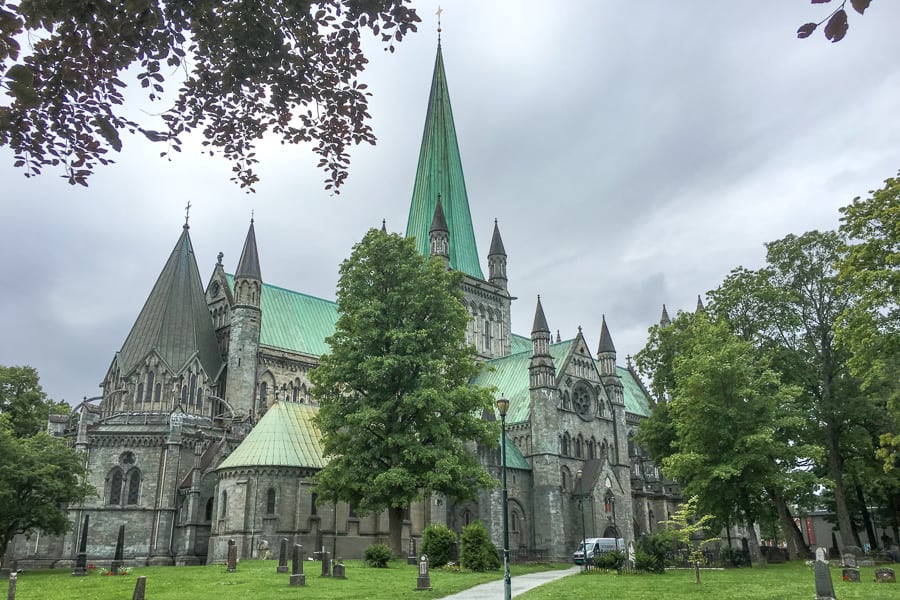
Next door, the Archbishop’s Palace, with its archaeological museum and mint workshop are also worth seeing while you are here, and if you’re an art lover, Trondheim Art Museum is just around the corner.
It’s a 5 minute walk along the wide, tree-lined Munkegatax, past the town hall (Rådhuset) to reach Trondheim’s market square (Torvet), dominated by a column dedicated to Olav Tryggvasson. It’s a focal point for life in Trondheim and you’ll often find festivals and events taking place here.
We lucked out with our visit coinciding with Trøndelag Food Festival, and we spent several happy hours here sampling delicious food stalls and partaking in a craft ale or three in the beer tent. In 2025, the festival will be held between 31 July and 2 August.
Continue a couple hundred metres further up the road to Stiftsgården, the King’s official 18th century royal residence and one of the largest wooden buildings in northern Europe. It’s open to the public during summer with visits by guided tour only. See the Visit Trondheim website for more details.
Trondheim Microbrewery and ØX Tap Room are just around the corner from Stiftsgården, so we’d highly recommend finishing today’s walk by sampling a few local brews while deciding where to go in Norway’s gastronomic capital for dinner.
Trondheim for Foodies
With Michelin starred restaurants, a focus on local produce and gastronomic innovation, and more good restaurants than you can poke a stick at, Trondheim is very much an established foodie favourite.Add to that a thriving microbrewery scene and it’s no surprise we loved visiting Trondheim as much as we did.
Day 14 – Trondheim to Oslo
Highlights: Trondheim to Oslo Scenic Drive
Total driving distance: appx. 500km (311 miles)
Total driving time: appx. 6.5 to 9.5 hours depending on the route chosen
Overnight: Oslo (if flying the next day)
If you want to save yourself a fairly long drive you could consider finishing your car rental in Trondheim, and either fly or get the train back to Oslo for your flight out.
If you plan to drive, the two most direct routes back to Oslo are: the 500km more easterly route along the E6 and Rv3 via Aldval and Rena which takes around 6.5 hours; and the more westerly route along the E6, Rv4 and E16 via Otta and Lillehammer, which adds around 20km and 45 minutes to the journey.
While neither drive will eclipse the more memorable journeys we’ve taken during this road trip in Norway, both are still pleasant enough and offer a handful of things to see and do along the way.
More Direct Eastern Route to Oslo (6.5 to 7.5 hours driving time)
Both routes follow the E6 out of Trondheim. After around 45 minutes you’ll reach Støren, where you have the option to take a detour to Røros via the Fv30 or continue on the more direct E6 and Rv3.
World Heritage-listed Røros is renowned for its well-preserved wooden buildings and mining history, so if you don’t mind adding around 45 minutes onto today’s drive, then it may well be worth a visit.
If you want to bypass Røros, continue on the E6 and then Rv3 until you get to one of the largest canyons in northern Europe, Jutulhogget Canyon, around 3 hours from Trondheim. There are plenty of hiking options around here, including treks down into the canyon itself, but you can also get views of the canyon by walking a few minutes from the car park.
From here, the road follows the Rv3 for a couple of hours as it skirts the Glomma, Norway’s longest river, before cutting south west and joining up with the E6 for the final leg into Oslo.
Points of interest along the final stretch (which apply to both the east and west route options) include the ruined medieval cathedral and museum at Domkirkeodden near Hamar, Eidsvoll Manor House and museum where the Norwegian Constitution was signed in 1814, and the atmospheric (some say haunted) Nes Church Ruins, located at the picturesque junction of the Glomma and Vorma rivers.
Western Route to Oslo (7.5 to 9.5 hours driving time)
The slightly slower western route takes you out of Trondheim, but instead of taking the Rv3 it continues on the E6 through the mountain ranges of Dovrefjell and Rondane national parks.
With more time there are an abundance of hiking options in this region to explore. After around three-and-a-half hours you’ll reach the town of Otta. It’s the main town of the Rondane and around halfway to Oslo, so may provide a useful stopping point for lunch.
From Otta, you have a couple of options. Either continue on the E6 all the way to the former winter Olympic town of Lillehammer, or take a two-hour diversion along the Fv51 and Fv33 to incorporate Norway’s Valdresflye scenic route via Jotunheimen National Park.
By all accounts, the 49km Valdresflye route, which can really only be attempted during the summer months, is a truly spectacular drive with incredible mountain views. So if you don’t mind a very long day, it might just be a very fitting way to end your Norway adventure.
Depending on your flight schedule, you can either depart from Oslo tonight or spend one more night in the city to explore any remaining attractions or indulge in the vibrant nightlife before concluding your memorable Norwegian road trip.
Sound like your kind of adventure? If you’ve got any questions about our Norway road trip itinerary, or driving in Norway, ask us in the comments below.
If you’re looking for more great road tripping itineraries and adventures, check out our Road Trips page, and our bucket list of 100 ultimate road trips around the world.

Bonjour,
superbe reportage fort passionnant à lire, félicitation pour tout ce travail !
J’essaye actuellement de planifier un tel road trip de +- 15 jours, mais les distances et le temps estimé (via goolge et via abpr pour comparer deux sites), me donnent du fil à retordre. Idéalement, je ne souhaiterai pas dépasser un trajet de +- 3-4 hr tous les deux jours, mais cela semble compliqué vu la géographie du pays.
Quand je lis votre parcours, une petite question me vient à l’esprit; n’était il pas un peu “speed” ou sous une certaine petite pression dans le sens que vous vous êtes infligé souvent des journées avec de très longues distances ? Perso, j’aurai du mal à convaincre mon épouse de passer un jour sur deux en voiture pour gagner du temps. De même, sur les sites de location, on propose presque tacitement une voiture électrique, était-ce le cas ? Car les arrêts (selon le planificateur) sont aussi nombreux et allongent le parcours….
Hi Gérard,
Thanks for your comment.
It’s fair to say Norway is a pretty big country and there are indeed a couple of very long driving days in this two week itinerary.
While in most cases, the driving legs are themselves highlights as much as the destination, we appreciate long drives won’t work for everyone.
If you’d prefer to limit yourself to 3-4 hours driving every other day you really have a few options to consider:
• making the trip a few days longer to give yourself more driving and overnight breaks;
• flying a couple of the longer legs; or
• adjusting the itinerary to visit fewer places (depending on your interests), for example looping back to Oslo from Geiranger rather than going further north.
There are always trade-offs with these kinds of decisions, and it is very much a personal choice depending on your specific circumstances and interests.
Since we travelled with our own petrol vehicle, we’re probably not best placed to comment on the impact an EV might have on the trip. However, it is worth noting EV cars are pretty much the norm in Norway so I would imagine charging infrastructure would be pretty good.
We hope your planning is coming along well and that this helps in some way.
Do you need reservations for the ferry crossings with the car? Specifically, the ones from Stavanger > Bergen?
Hi Melissa, thanks for your message and apologies for the slow reply.
From our experience regular car ferries in Norway operate on a first come, first served basis and can’t be booked in advance. In summer and other peak periods, it’s advisable to plan ahead, arrive as early as you can, and be prepared for queues.
While we drove between Stavanger and Bergen, we understand that Fjordline operates a ferry between the two which takes 5 hours 30 minutes. It looks like you can book tickets for this through booking sites like Ferryhopper and Direct Ferries.
Hope this helps.
Great detail as so many options from planned to DIY options for a road trip. I read the speed limit is 45mph. Are the travel times you listed based on this 45mph
Hi there Nils,
Thanks for your comment, there truly are infinite options when it comes to road tripping in Norway.
Speed limits in Norway vary depending on the location and type of road, so residential, urban, country, and dual carriageway roads all have different limits.
We generally base our travel times on Google maps, and although they don’t disclose the specifics of the calculation, we believe it to be based on distance, speed limits, and traffic data.
We’ve published more detail on driving in Norway here.
thank you for such a comprehensive article! I am starting to plan a road trip…coming from Australia.
Thanks Anita, glad you found it helpful.
Hope you have a fabulous trip, Norway is one of our faves 🙂
Hi May I ask approximate how much you spent on petrol for the entire trip?
Thank you
Hi there Dee, thanks very much for the comment.
Unfortunately we weren’t very diligent with tracking our budget in Scandinavia and also did a fair few diversions from this route, so we don’t have an accurate record of our petrol spend.
For budgeting purposes you’d need to consider the fuel efficiency of your vehicle.
Our slightly older car only gets around 10 to 15km per litre (around 35 miles per gallon). If you were only getting that kind of fuel economy you’d be looking at close to US$500 to cover the 2,800km in this trip, assuming you averaged NOK23 per litre on fuel costs.
If you are hiring a newer car however you might well be able to expect better fuel consumption.
Hope that’s a helpful start.
Regards
John
You didnt mention speeding. I hear the Nords are ruthless for speeders and its a % of your income, vs a flat fine.
Hi CP, thanks for your feedback. Road rules are indeed strictly enforced in Norway and speeding can attract hefty fines, loss of licence, even prison time. From what we’ve come across on various Norwegian websites, speeding fines are fixed rates based on the speed zone and the speed travelled over the limit in that zone. Personally, we found the scenery so amazing on these drives, we just wanted to take as much time as possible!